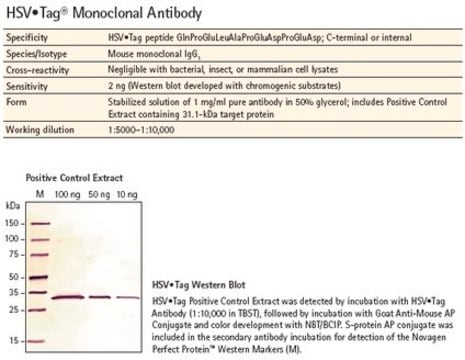71590-M
StrepTag™ II Monoclonal Antibody
Novagen®
Synonym(s):
Purified monoclonal antibody, Purified mouse monoclonal antibody
Sign Into View Organizational & Contract Pricing
All Photos(1)
About This Item
UNSPSC Code:
12352203
NACRES:
NA.43
Recommended Products
biological source
mouse
Quality Level
antibody form
purified antibody
antibody product type
primary antibodies
clone
monoclonal
form
liquid
manufacturer/tradename
Novagen®
storage condition
OK to freeze
technique(s)
western blot: suitable
storage temp.
−20°C
General description
The StrepTag II Monoclonal Antibody is a mouse monoclonal antibody (IgG1) that has high specificity and affinity for the 8-aa StrepTag II peptide. The purified antibody produces a strong signal at a 1:1000 dilution for Western blots and dot blots. This monoclonal antibody can detect as little as 5 ng StrepTag II fusion protein and displays negligible cross-reactivity with bacterial, mammalian, and insect lysates. The antibody is supplied lyophilized and should be reconstituted in phosphate buffer saline (PBS) at a concentration of 0.2 mg/ml. The StrepTag II monoclonal antibody is suitable for chemiluminescent and colorimetric detection.
Application
StrepTag II Monoclonal Antibody has been used for:
- western blotting(1:1000)
- sodium dodecyl sulfate-polyacrylamide gel electrophoresis (SDS-PAGE)
- immunoprecipitation
Components
100 µg Strep•Tag II Monoclonal Antibody
Warning
Toxicity: Standard Handling (A)
Legal Information
NOVAGEN is a registered trademark of Merck KGaA, Darmstadt, Germany
StrepTrap is a trademark of Cytiva
Not finding the right product?
Try our Product Selector Tool.
Storage Class Code
11 - Combustible Solids
WGK
WGK 1
Flash Point(F)
Not applicable
Flash Point(C)
Not applicable
Certificates of Analysis (COA)
Search for Certificates of Analysis (COA) by entering the products Lot/Batch Number. Lot and Batch Numbers can be found on a product’s label following the words ‘Lot’ or ‘Batch’.
Already Own This Product?
Find documentation for the products that you have recently purchased in the Document Library.
Global post-translational modification profiling of HIV-1-infected cells reveals mechanisms of host cellular pathway remodeling
Jeffrey R J, et al.
Cell Reports, 39(2), 110690-110690 (2022)
Peter Oatley et al.
Scientific reports, 10(1), 14089-14089 (2020-08-26)
Surface layers (S-layers) are protective protein coats which form around all archaea and most bacterial cells. Clostridium difficile is a Gram-positive bacterium with an S-layer covering its peptidoglycan cell wall. The S-layer in C. difficile is constructed mainly of S-layer
Kostika Sofroni et al.
The Journal of cell biology, 219(8) (2020-07-02)
Precise control of cytoskeleton dynamics and its tight coordination with chromosomal events are key to cell division. This is exemplified by formation of the spindle and execution of cytokinesis after nuclear division. Here, we reveal that the central cell cycle
Mariel Kleer et al.
PLoS pathogens, 18(8), e1010724-e1010724 (2022-08-24)
A dysregulated proinflammatory cytokine response is characteristic of severe coronavirus infections caused by SARS-CoV-2, yet our understanding of the underlying mechanism responsible for this imbalanced immune response remains incomplete. Processing bodies (PBs) are cytoplasmic membraneless ribonucleoprotein granules that control innate
A Gaballa et al.
mSphere, 6(1) (2021-01-08)
Salmonella enterica encodes a wide array of virulence factors. One novel virulence factor, an A2B5 toxin known as the typhoid toxin (TT), was recently identified among a variety of S. enterica serovars. While past studies have shown that some serovars
Our team of scientists has experience in all areas of research including Life Science, Material Science, Chemical Synthesis, Chromatography, Analytical and many others.
Contact Technical Service








